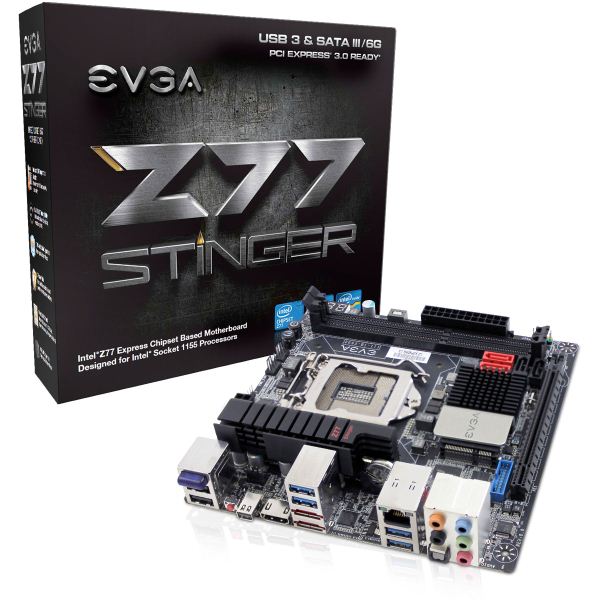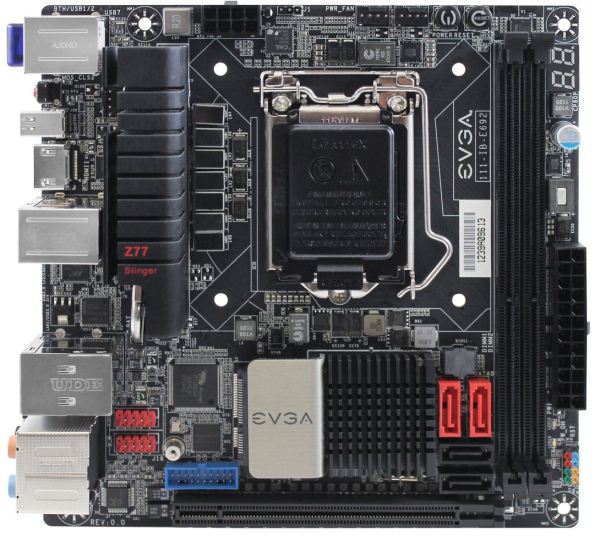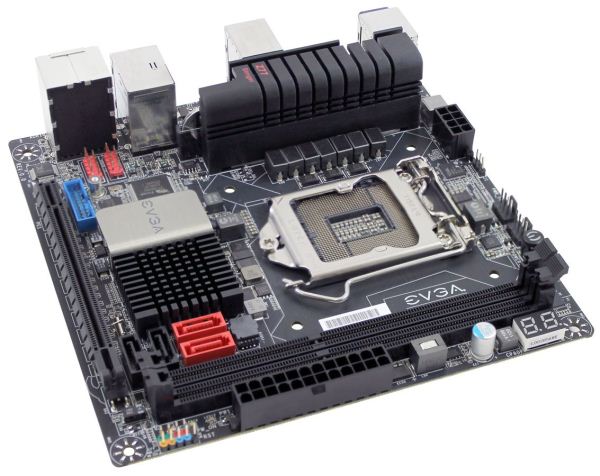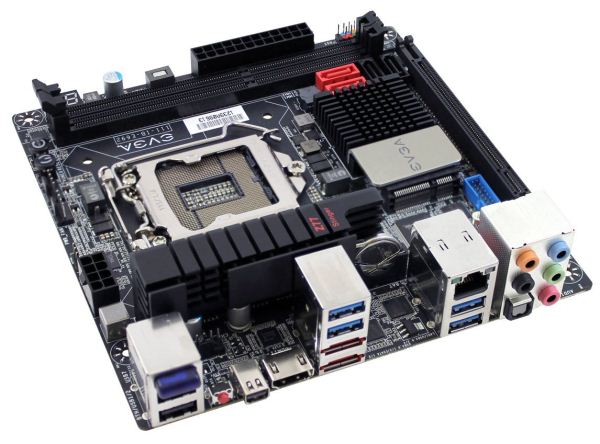Z77 mITX Round-Up: Five of the Best – MSI, Zotac, ASRock, EVGA and ASUS
by Ian Cutress on December 31, 2012 7:00 AM EST- Posted in
- Motherboards
- MSI
- ASRock
- EVGA
- ZOTAC
- Asus
- Ivy Bridge
- Z77
- mITX
EVGA Z77 Stinger Overview
For the fourth motherboard of this review, the design philosophy of the Z77 mITX board takes a turn on its head – almost literally. We find the socket moved to the top, and the chipset placed underneath. This ultimately gives more freedom when it comes to placing CPU coolers, albeit the EVGA Z77 Stinger is still limited in one dimension due to the close proximity of the memory slots. Users can happily place a longer cooler in the other direction though.
As a price of $200, it certainly raises the asking cost for a mITX board to new heights. A good number of great ATX sized motherboards are already at this price, including a few we have awarded. This instantly makes the EVGA a tougher sell, but in order for a little compensation, EVGA get heavy handed with some of the features.
We get an Intel NIC on board unlike the other mITX so far, but on the downside it is coupled with the Realtek ALC889 which failed our 192 kHz testing. We get a mini-PCIe slot, though with no WiFi module like with some of the other boards. EVGA have decided to up the total USB 3.0 count to six with an ASMedia controller powering the onboard header as well as upping the SATA 6 Gbps count with a Marvell controller powering the two eSATA 6 Gbps on the rear IO. The EVGA is also one of few boards to have the power/reset button combination with a debug LED that changes to a CPU temperature monitor after POST. If anything the rear IO looks a little sparse, with HDMI and mini-DisplayPort being the only options for video output. It looks like some of the connectivity had to be lost in order to fit a couple of the controllers on board.
EVGA are still not completely on the bandwagon with a graphical and interactive BIOS, showcasing a white text on black scenario. To make matters worse, XMP is not properly implemented in the first BIOS release, and returning to optimized defaults changes everything back to normal except the BCLK. On the software side, the driver install is a one-by-one affair which requires user interaction despite the fact that these driver installs when sent to EVGA offer silent install modes. The only software we get is EVGA E-LEET which allows the user to adjust the overclocks and priority of programs on the fly – it is for all intents and purposes an advanced version of CPU-Z. Fan control is not in the software – that is solely for the BIOS.
Performance of the EVGA is on par with the other motherboards tested – nothing comes out as overly great or bad. This makes a $200 mITX a tough sell – it has the socket position I prefer and an Intel NIC, but the support behind the motherboard in terms of the BIOS or Software pale in comparison to the cheaper models. One upside of purchasing an EVGA board is that all RMA requests are direct with EVGA rather than the supplier, which may add to that additional cost as well.
Visual Inspection
As noted in the overview, the main comparison with the previous motherboards and the EVGA is the location of the socket area. Here the socket is above the chipset, which changes a lot to do with port location. Our 8-pin CPU power connector is now at the top edge of the board with a pair of four-pin fan headers. As the chipset is underneath the socket, so are the USB 2.0 and USB 3.0 headers and the SATA ports. The result is a mixed bag, with USB cables having to stretch over components in order to fit into the board.
Unlike most of the other mITX boards, we get three fan headers – two located to the top right of the socket (both 4-pin) and another on the rear IO side of the power delivery heatsink (also 4-pin). The socket area still caters in the left-right direction to the Intel minimum specifications, meaning that coolers that conform to at least one of the dimensions should be placed such that any full sized memory does not interfere.
With the chipset below the socket, our SATA ports are in the bottom right area between the memory slots and the PCIe device. The orientation of the SATA ports is going to give issues if any need to be taken out, requiring most of them to be removed each time. To the left of the chipset is a mini-PCIe (not mSATA) port for a WiFi/WiDi module, which is not included in the package – this is in contrast to the other mITX motherboards tested which do have one.
Along the top right of the motherboard are a pair of power/reset buttons which I always find useful in testing. To the right of these is a two-digit debug LED, also useful for diagnosing issues. This two-digit debug LED turns into a CPU temperature readout after POST, which is an awesome feature to have. Unlike some other mITX builds, the Front Panel connector is found at the bottom right of the motherboard in an ideal location for most orientations.
The rear IO panel is a little different to the previous motherboards tested. Normally the rear IO is fighting for space to fit in all the different connectors wanted on the product, but EVGA have decided to cut some of the fluff and stick to components they think most of their users will want to use. From left to right we have a BlueTooth module, two USB 2.0 ports, a Clear_CMOS button, a mini-DisplayPort, HDMI, four USB 3.0, two eSATA 6 Gbps, an Intel NIC, and audio jacks from the Realtek ALC889.
Board Features
| EVGA Z77 Stinger | |
| Price | Link |
| Size | Mini ITX |
| CPU Interface | LGA-1155 |
| Chipset | Intel Z77 |
| Memory Slots |
Two DDR3 DIMM slots supporting up to 16 GB Up to Dual Channel, 1066-2133 MHz |
| Video Outputs |
HDMI mDP |
| Onboard LAN | Intel 82574L |
| Onboard Audio | Realtek ALC889 |
| Expansion Slots |
1 x PCIe 3.0 x16 1 x mPCIe |
| Onboard SATA/RAID |
2 x SATA 6 Gbps (Chipset) RAID 0, 1, 5, 10, 0+1 2 x eSATA 6 Gbps (Marvell) RAID 0, 1, 5, 10, 0+1 2 x SATA 3 Gbps (Chipset) RAID 0, 1 |
| USB |
4 x USB 3.0 (Chipset) [4 back panel] 2 x USB 3.0 (ASMedia ASM1042) [2 onboard] 6 x USB 2.0 (Chipset) [2 back panel, 4 onboard] |
| Onboard |
2 x SATA 6 Gbps 2 x SATA 3 Gbps 1 x USB 3.0 Header 2 x USB 2.0 Headers 1 x Front Panel Header 3 x Fan Headers Power/Reset Buttons Debug LED |
| Power Connectors |
1 x 24-pin ATX Power Connector 1 x 8-pin CPU Power Connector |
| Fan Headers |
1 x CPU (4-pin) 2 x PWR (4-pin) |
| IO Panel |
1 x Bluetooth Module 2 x USB 2.0 1 x Clear_CMOS Button 1 x mDP 1 x HDMI 4 x USB 3.0 2 x eSATA 6 Gbps 1 x Intel NIC Optical SPDIF Output Audio Jacks |
| Warranty Period | 3 Years |
| Product Page | Link |
For the large $200 price tag for the Z77 Stinger, the lack of a WiFi module on board is a little disappointing, as well as the use of the Realtek ALC889 rather than anything higher up the Realtek order catalogue. On the plus side we do get an Intel NIC, an additional USB 3.0 controller, an additional SATA 6 Gbps controller (for eSATA ports) and, in my opinion, a better oriented mITX motherboard. Also that third fan header is one more than most mITX motherboards.














54 Comments
View All Comments
mike_b - Monday, December 31, 2012 - link
Interesting article, but I have to ask why would someone spend more for a Z77 chipset when using 'just' an i3? Surely a much cheaper H61 chipset could do the job admirably, and at much lower cost.Z77 makes sense if you're overclocking, which is excluded from this test...
IanCutress - Monday, December 31, 2012 - link
H61 has no chipset USB 3.0, no chipset SATA 6 Gbps, and you are limited to PCIe 2.0. H61 is also technically limited to one single sided DIMM per channel, and no SATA RAID. There's also SRT to consider, that would be advantageous with the ASRock and the mSATA on the rear.Ian
mike_b - Monday, December 31, 2012 - link
It might make an interesting comparison to see what net advantage is gained with the added features of the Z77 chipset compared with the H61. If budgets are limited the ~100 dollar cost difference between the Z77 and H61 mainboards makes a big difference; that money saved could be put into something which makes more of a performance difference (SSD rather than HDD for example).Anandtech is one of the best tech sites around, you guys do a great job. I do sometimes see though an emphasis on more expensive products when in terms of real-world performance you could get almost the same thing at a much cheaper price. Might be worth mentioning somewhere.
Not least because with yet another new socket coming with Haswell all these 1155 boards will be seen as out of date soon anyway.
IanCutress - Monday, December 31, 2012 - link
Once we get into the swing with Haswell, we will hopefully covering the whole spectrum. Though it is worth noting that motherboard manufacturers, want to put their best foot forward, and would prefer their halo/channel boards get covered before their OEM / low end offerings. Hence this is why you rarely see many mainstream reviews that are not from forums dedicated to the market segment and users testing their own equipment. We are hoping to rectify the balance in due course. If there are any specific products you might want us to test or examine, drop me an email and I'll see what I can put in my schedule (as full as it is[!]) :)Ian
StormyParis - Monday, December 31, 2012 - link
This is a major issue, not limited to motherboards: whenever I'm looking for something middle of the road or outright cheap, I can't find reviews.These Z77 MBs are a nice example: even though I'm recommending/building PCs regularly, most of them mini-ITX, I never came across a use case for Z77. Nobody apart from teens that still have something to prove overclocks anymore. People who want to do multi-GPU get a big case, and a big board. Are we supposed the extrapolate that the makers of good Z77 boards also make good H77 and H61 boards ?
I understand you've got to make do with what you're given by the OEMs. And that reviews was very good, as usual. Pity it is irrelevant ?
Tech-Curious - Monday, December 31, 2012 - link
That's an interesting observation. I have to say, I never noticed a significant lack of coverage for low-to-mid-range components (either in general or on Anandtech in particular), until this Fall, when I was in the market for a lower end motherboard.I guess I just always gravitated to higher end mobos before. Or maybe the coverage for such products was more comprehensive years ago. My memory's foggy, so it's hard to say.
In any case, motherboards appear to be the exception. If anything, I think the internet has generally grown more bullish on low-to-mid-range CPUs and GPUs in recent years (probably, in part, as a result of the stagnating console situation, which results in stagnating system requirements for games).
But all of that rambling aside, yeah. It'd be nice to see more diverse motherboard analysis. When I bought a b75 a couple of months ago, I literally couldn't find a review for that chipset. It wasn't a big deal; it's not like b75's features are any great mystery, after all -- but it is a little nettlesome to trip over sixty bajillion z77 reviews when there's nary peep about any other chipset.
In other news, Ian's review is a good one -- and given that I've been a faithful user of Asus motherboards for the last 15 years, it's nice to see them take home the prize. :)
Etern205 - Saturday, January 5, 2013 - link
My guess would be, why review a cheap board when majority of the readers here won't even bother buying it?And as for Asus boards, I've heard, they do something called based-line features. This means all boards from the bottom of the range to the top (Intel B75-Z77) will have the same base-line features, other features are just added like BT, WiFi, extra lan, etc.
Tech-Curious - Wednesday, January 9, 2013 - link
Yes, I think the issue is that (at least with respect to Intel chipsets) low-end motherboards don't support overclocking. So they're both less interesting to review (fewer measurable differences in performance among different models), and they're less appealing to the presumed audience of sites like Anandtech.Still, the B75 is a perfectly good chipset. If you aren't heavily invested in overclocking, z77's advantages are likely wasted on you. Personally, I'm well beyond my overclocking days; I just don't have the time or the patience to go through the almost endless tuning process anymore. (Even if you find a stable OC at the outset, it can become unstable later, and/or a given application might expose instability that stress testing didn't, weeks or even months down the road).
jonjonjonj - Friday, January 4, 2013 - link
just cause you don't overclock doesn't mean other people don't. why wouldn't you? because you want to get the fastest cpu that you can afford means you have something to prove? some people are just idiots.Zap - Monday, December 31, 2012 - link
But there isn't a $100 difference between H61 and Z77. There is a cheaper Gigabyte Z77 ITX board that's only around $60 more than the cheapest H61 ITX board, and it was even on sale recently for another $13 off making it less than $50 difference.Alternately one can go the H77 ITX route and get all the Z77 goodies except for overclocking, for around $30 less than the cheapest Z77 ITX. I think $30 more than H61 is reasonable for those extra features, plus guaranteed out-of-the-box BIOS support for Ivy Bridge.
I do agree with your (mike_b) first post regarding the choice of CPU used. Ian Cutress, didn't you have a spare K CPU laying around? There are so many people building overclocked ITX rigs these days. I did in a Silverstone SG05 with low profile air cooler to hit 4.2GHz. Plenty of others use the Bitfenix Prodigy and liquid cooling to hit clocks normally reserved for ATX rigs. Another review site (Tweaktown) tested overclocking on Z77 ITX boards and the ASRock hit near 4.8GHz. THAT'S what I want to see.
Of course this AnandTech roundup has some very useful information too, such as DPC latency tests and POST times. Keep up the good work there! But please, know your audience. Next time if the board is supposed to be overclockable, test that feature.
Maybe there can be a companion article about overclocking and heatsink clearance? Would be a shame to not overclock this nice collection of Z77 ITX boards.